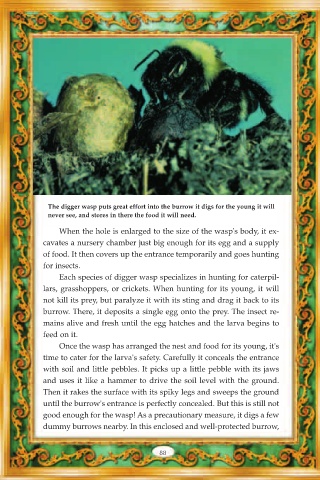Page 90 - Devotion Among Animals Revealing the Work of God
P. 90
The digger wasp puts great effort into the burrow it digs for the young it will
never see, and stores in there the food it will need.
When the hole is enlarged to the size of the wasp's body, it ex-
cavates a nursery chamber just big enough for its egg and a supply
of food. It then covers up the entrance temporarily and goes hunting
for insects.
Each species of digger wasp specializes in hunting for caterpil-
lars, grasshoppers, or crickets. When hunting for its young, it will
not kill its prey, but paralyze it with its sting and drag it back to its
burrow. There, it deposits a single egg onto the prey. The insect re-
mains alive and fresh until the egg hatches and the larva begins to
feed on it.
Once the wasp has arranged the nest and food for its young, it's
time to cater for the larva's safety. Carefully it conceals the entrance
with soil and little pebbles. It picks up a little pebble with its jaws
and uses it like a hammer to drive the soil level with the ground.
Then it rakes the surface with its spiky legs and sweeps the ground
until the burrow's entrance is perfectly concealed. But this is still not
good enough for the wasp! As a precautionary measure, it digs a few
dummy burrows nearby. In this enclosed and well-protected burrow,
88

